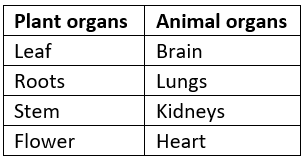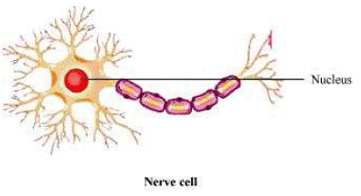Lakhmir Singh & Manjit Kaur: Cell Structure and Functions- 2 | Lakhmir Singh & Manjit Kaur Solutions: Class 8 Science PDF Download
Q.31. What is a ‘cell’ in biology?
Cell is structural and functional unit of all living beings.
Q.32.
(A) What are the basic parts of all the cells?
The basic parts of all the cells are – cell membrane, cytoplasm and nucleus.
(B) What parts are present only in plant cells?
The parts which are present only in plant cells are – Cell wall, chloroplasts and large vacuole.
Q.33. What controls the flow of substance in and out of a cell?
Plasma membrane controls the flow of substance in and out of a cell.
Q.34. Which part of a cell controls all the activities of the cell?
Nucleus controls all the activities of the cell.
Q.35. Name the animal cell which is long and has thread-like branches.
Nerve cell is a long and has thread like branches.
Q.36. What is the function of chloroplasts in a plant cell?
Chloroplasts help in the synthesis of food by the process of photosynthesis.
Q.37. Name an organism which has no definite shape, and it keeps on changing its shape.
Amoeba has no definite shape, and it keeps on changing its shape.
Q.38. Name one cell in human body which is spherical in shape.
Red blood cell is spherical in shape.
Q.39. Which organism has the smallest cell?
Bacteria mycoplasma is the smallest cell measuring 0.1 micrometer.
Q.40. Name the biggest cell?
The largest cell measuring 170 mm × 130 mm, is the egg of an ostrich.
Q.41. Name two animal organs and two plant organs.
There are different animal organs. Some of the names are Heart, Stomach, brain and lungs. Stem, Leaf, Roots etc are plant organs.
Q.42. Name two plant organ which is responsible for:
(a) Making of food.
(b) Absorption if water and minerals.
(a) Leaves are responsible for synthesis of food.
(b) Plant roots help in the absorption water and minerals.
Q.43. Which of the two does not have a true nucleus: prokaryotic cell or eukaryotic cell?
Prokaryotic cell does not have a true nucleus.
Q.44. Name one prokaryotic cell and one eukaryotic cell.
Prokaryotic cell – Blue green algae
Eukaryotic cell – Onion peel cell
Q.45. Fill in the blanks with suitable words:
(a) Cells were first observed in cork by _________ in 1665.
(b) What is brick to a house is _________ To an organism.
(c) The cytoplasm and nucleus make up the _________
(d) The shape and size of a cell is related to its _________
(e) The bacteria cells are _________ to _________ micrometer in length.
(f) The smallest unit of life is a _________
(g) Tissues make up _________
(h) Organ systems make up an _________
(i) Cells make up _________
(j) Organs make up _________
(a) Robert Hooke
(b) Cell
(c) Protoplasm
(d) Function
(e) 0.1; 0.5
(f) Cell
(g) Organs
(h) Organism
(i) Tissue
(j) Organ system
Short Answer Type Questions
Q.46. Why are plant and animal specimens usually stained with dyes before observing them through a microscape ? Name one stain (or dye) used for this purpose.
The various parts of the cell are colorless and hence, difficult to distinguish. So, various stains are used to colour the parts of the cell to study the detailed structure through a microscope.
The dyes (stains ) which are used in the study of cell structure are methylene blue, dilute iodine solution, etc.
Q.47. What is a tissue? Give two examples of tissues.
A tissue is a group of similar cells performing a specific function.
Examples – Epithelial tissue, muscle tissue.
Q.48. What is an organ? Give two examples of organs.
A organ is a group of different tissues which work together to perform a specific function in the body of an organism.
Examples – Organs in the animal body – Brain and kidney
Organs in the plant body – Root and leaves.
Q.49. What is an organ system?
(a) Give two examples of organ systems in animals.
(b) Name the two main organ systems in plants.
Organ system – A group of closely related organs that work together to perform a specific function for the organism is called organ system.
(a) Muscular system and digestive system are examples of organ systems in animals.
(b) Root system and shoot system are main organ systems in plants.
Q.50. Which of the following are plant organs and which are animal organs?
Brain, Leaf, Lungs, Roots, Stem, Kidneys, Flower, Heart
Q.51. What are the functions of the following organs ?
(a) Heart
(b) Brain
(c) Roots
(d) Leaves
(a) Heart – It pumps blood throughout the body.
(b) Brain – It controls the activities of other parts of the body.
(c) Roots – These help in absorption of water and minerals.
(d) Leaves – These are responsible for synthesis of food.
Q.52. What is the shape of red blood cells in human blood? What function do red blood cells perform ?
Red blood cells (RBCs) are usually spherical in shape. The main function of red blood cells is to carry oxygen from the lungs to the tissues around the body.
Q.53.
(A) State the difference between prokaryotes and eukaryotes.
Prokaryotes have nuclear material without nuclear membrane whereas eukaryotes have well organized nucleus with a nuclear membrane.
(B) Name two prokaryotes and two eukaryotes.
Prokaryotes – Blue green algae and bacteria
Eukaryotes – Onion cells and cheek cells
Q.54.
(A) Why are nerve cells long and have branches?
Nerve cells (neurons) are long, branched and have thread-like projections so that they can connect other nerves cells and transmit messages over long distance.
(B) What is the other name of a nerve cell?
The other name of a nerve cell is neuron.
Q.55.
(A) Why could cells not be observed and studied for thousands of years?
Most of cells are extremely small and cannot seen with naked eye, hence cells could not be observed and studied for thousands of years.
(B) State the cell theory of organisms.
Two biologists, Schleiden (1839) and Schwann (1839) presented the cell theory. This stated that all the plants and animals are composed of cells and the cell is the basic unit of life.
Q.56. Explain the function of mitocheondria in a cell.
Mitochondria is the site of cellular respiration or oxidation of food in a cell. It uses glucose and oxygen to produce energy. Hence, it is knowns as “Powerhouse of the cell”.
Q.57. Make a sketch of human nerve cell. What function do nerve cells perform?
The function of nerve cell: The nerve cell receives and transfers messages, thereby helping to control and coordinate the working of different parts of the body.
Q.58. Make a sketch of the human muscle cell. What are the functions do muscles cell perform?
The muscle cells are responsible for movement in our body by contracting and relaxing.
Q.59. What are pseudopodia in Ameoba? What are the functions of pseudopodia?
The finger-like projection of varying lengths protruding out of the body of Amoeba, is called pseudopodia. These projections appear and disappear as Amoeba moves or feeds.
Thus, the function of pseudopodia is to facilitates movement and help in capturing food.
Q.60. Where are chromosomes found in a cell ? State their function.
Chromosomes are thread-like structures usually present in the nucleus that become visible only during cell divisions. The function of chromosomes is to transfer the characters from parents to the off springs through the genes located on them.
























